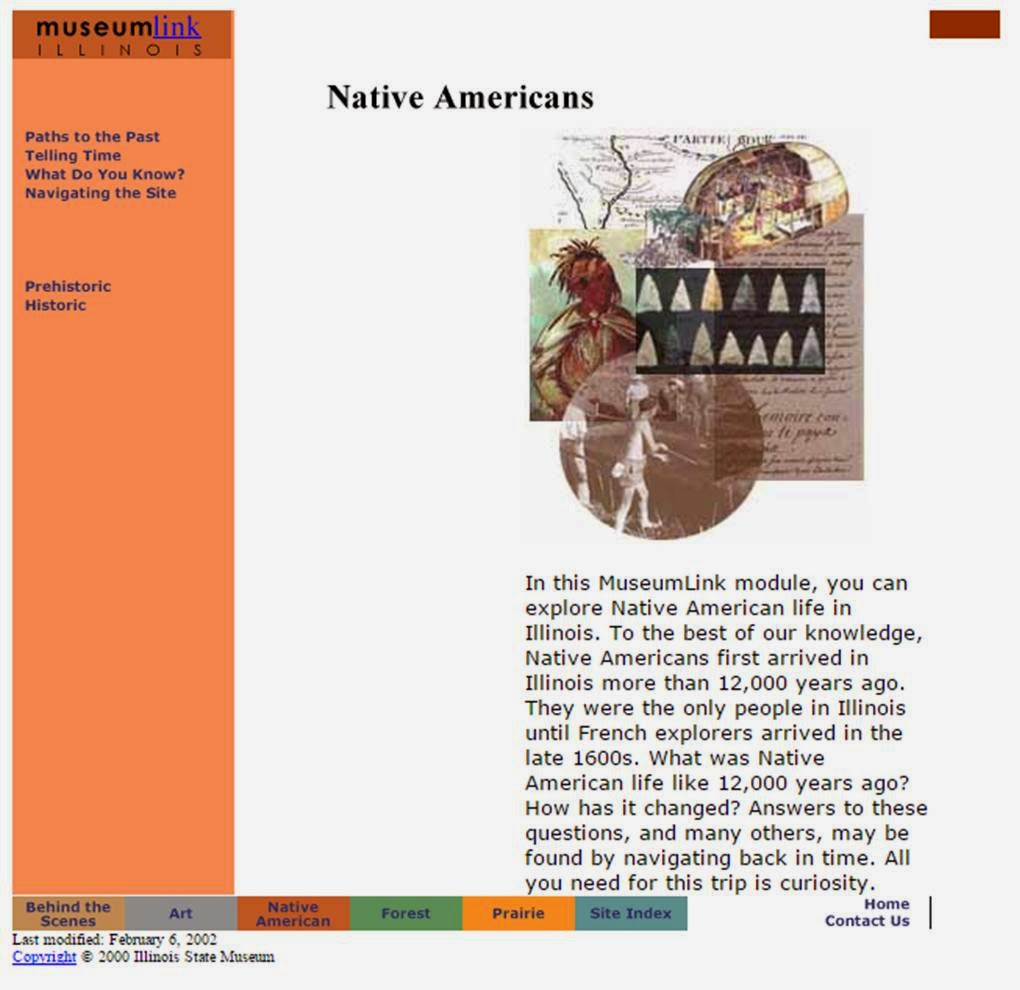"In this MuseumLink module, you can explore Native American life in Illinois. To the best of our knowledge, Native Americans first arrived in Illinois more than 12,000 years ago. They were the only people in Illinois until French explorers arrived in the late 1600s. What was Native American life like 12,000 years ago? How has it changed? Answers to these questions, and many others, may be found by navigating back in time. All you need for this trip is curiosity."
Telling Time
Relative vs. Absolute Dating Methods.
What Do You Know About Native American History?
Debunking common stereotypes.
Prehistoric
| Clovis points, Kimmswick, Missouri (left)and St. Clair County, Illinois (right). Image Courtesy of museumlinkIllinois. |
- Archaic
- Identity
- Environment
- Climate
- Plants
- Animals
- Economy
- Clothing
- Food
- Settlement
- Trade
- Technology
- Shelter
- Tools & Utensils
- Containers
- Weapons
- Transportation
- Society
- Beliefs
- Archaeological Sites
- Woodland
- Identity
- Environment
- Climate
- Plants
- Animals
- Economy
- Clothing
- Food
- Settlement
- Trade
- Technology
- Shelter
- Tools & Utensils
- Containers
- Weapons
- Society
- Beliefs
- Archaeological Sites
- Mississippian
- Identity
- Environment
- Climate
- Plants
- Animals
- Economy
- Clothin
- Food
- Settlement
- Trade
- Technology
- Society
- Beliefs
- Archaeological Sites
- Late Prehistoric
- Identity
- Environment
- Climate
- Plants
- Animals
- Economy
- Clothing
- Food
- Settlement
- Trade
- Technology
- Shelter
- Tools & Utensils
- Containers
- Weapons
- Transportation
- Society
- Beliefs
- Archaeological Sites
- Glossary
- Activities and Resources
- Pictionary with the Past
- Mississippian Regalia
- Mississippian Gorget
- Pottery-making Methods
- Falcon Dancer Mask
- Additional Readings
- Culture History
- Regional Studies
- Additional Readings
- Teacher Orientation
- Scope of the Module
- Objectives
- Reading Level
- Resources for Teachers
- Navigation
- Content
Historic
- Illinois Country
- Climate
- Land
- Water
- Plants
- Animals
| "To paraphrase Mark Twain, rumors of our extinction are greatly exaggerated. Tribal members are active in promoting economic development, cultural and historical preservation, education, and health care programs for tribal members and other Indian people." (Steve Kinder, Peoria Tribe of Indians of Oklahoma, 1999). Image Courtesy of museumlinkIllinois. |
- The Illinois Indians
- Identity
- Language
- Territory
- Appearance
- Economy
- Food
- Settlements
- Trade
- Division of Labor
- Technology
- Houses
- Tools and Utensils
- Containers
- Weapons
- Transportation
- European Trade
- Society
- Family
- Leaders
- Warfare
- Social Status
- Recreation
- Neighbors
- Beliefs
- Religion
- Calumet
- Health
- Death
- Folklore
- Art and Music
- Art
- Music
- History
- European Contact
- Exploration
- Fur Trade
- The Illinois Decline
- The Illinois Today
- Archaeology
- Illinois Villages
- Zimmerman Site
- Starved Rock Site
- River L'Abbe Mission
- Waterman Site
- Ancestors
- How Do We Know?
- Written Records
- Archaeology
- Glossary
- Activities and Resources
- Comparison of Political Life
- Dye Plants
- Interview with Native American Teen
- Movie of Native American Teen Dancing
- Model Wigwam
- Plum-stone Dice Game
- Predicting the Past
- Someone's in the Kitchen
- Native American Recipes
- BSA Indian Lore Merit Badge
- Additional Readings
- Sorted by section
- Alphabetical bibliography
- Websites of Interest
- Teacher Orientation
- Objectives of the Module
- Reading Level
- Resources for Teachers
- Navigation
- Content
For more information,
Visit:

No comments:
Post a Comment